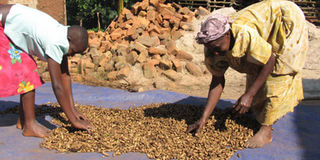Prime
Groundnut production increases as demand grows

Farmers put groundnut pods on tarpaulin to dry under the sun after harvest.PHOTO BY MICHAEL J. SSALI
Available statistics about groundnuts in Uganda have shown an increase in production mainly caused by growing demand for the food crop. Figures from the Uganda Bureau of Statistics indicate that national production increased from 126,000 metric tonnes in 1999/2000, to 219,000 metric tonnes in 2005/6. Groundnut paste makes quick sauce to be eaten with cooked bananas, potatoes, yams, cassava, millet, rice, ugali and other foodstuffs. It takes relatively a short time to prepare groundnut sauce and it does not require a lot of fuel. This makes it one of the most handy sauces especially for people in towns who return from work rather tired and want to quickly prepare a meal before going to bed to rest.
Roasted groundnuts make good accompaniment to coffee and tea. Nearly everywhere in our urban centres particularly along the streets, there are people vending roasted groundnuts measured out in small quantities, like for Shs200, Shs300 and Shs500. Shopkeepers grind the groundnuts into powder or into a paste which they sell to customers in measured amounts. Many parents want to provide their boarding school going children with roasted groundnuts and the demand for them increases as school holidays come to an end.
Groundnuts are an important source of protein and a raw material for edible oil. They are also used in making confectionaries. Their leaves are valuable to the farmer as they provide fodder rich in proteins.
Western Uganda is known to produce the highest amount of groundnuts at an estimated 107,000 metric tonnes annually followed by Eastern Uganda at 59,000, Northern Uganda at 36,000 and Buganda region at just 17,000. Thanks to the informal cross border trade, Tanzania’s groundnuts have in the recent years started to infiltrate into Uganda, and caused the average farm gate price for shelled groundnuts in the country to remain at about Shs2,500 a kilo. Sometimes, especially when some parts of the country experience prolonged rain shortage a kilo of shelled groundnuts gets to as much Shs3,500 or even higher in some towns.
It is not a bad idea then for a farmer these days to invest in groundnut production as the demand for the crop is big. The crop requires plenty of rain at least during the first two months and a good amount of sunshine in the third month when the crop begins to mature and becomes ready for harvesting. Some people these days are taking to drip irrigation and planting the seeds in rows, which ensures successful production especially when they have access to farm manure or phosphate fertilisers.
The field should be clear of weeds and the best soil for groundnut-growing should be fertile and loose to facilitate harvesting. During seedbed preparation all large clods of soil should be broken down. The mature plant is uprooted manually by lifting and the soil should not be so hard as to prevent some of the pods from coming out of the soil during harvesting.
Planting should take place at the beginning of the rain season. The farmer digs a small hole about six centimetres deep in which to plant one or two seeds. The holes should be quite close to one another, hardly a foot between. Weeding must be done early before the crop begins flowering.
Groundnuts are self-pollinated and it is the fertilised ovary, or the peg, which bends and grows into the ground where it develops into a pod which contains the nuts. Delayed weeding disturbs the process of the pegs growing into the ground. Similarly a hard ground occasioned perhaps by poor rains will make it difficult for the pegs to penetrate into the ground and lead to a poor harvest.
A hard ground will also complicate harvesting as some of the pods will remain stuck in the ground when the farmer lifts the matured plant. Yet digging them out with the hand hoe means more labour and chances of damaging the pods with the farmer’s hoe are quite high. At maturity the plant’s leaves become yellowish and eventually dry up and drop to the ground.
Close spacing leads to a dense plant population, reduces weed growth and also creates conditions unfavourable to aphids which cause groundnut rosette, a common disease for the farmer to worry about. Other diseases that sometimes attack the crop include leaf spot, groundnut blight, and bacterial wilt. However agricultural extension service providers always have a word of advice about most of the common groundnut diseases. Other worries have to do with rodents for which traps or scarecrows can be placed in the fields.




